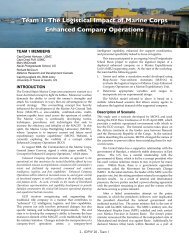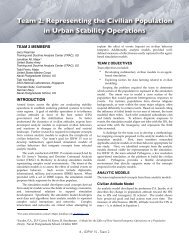pdf file - SEED Center for Data Farming - Naval Postgraduate School
pdf file - SEED Center for Data Farming - Naval Postgraduate School
pdf file - SEED Center for Data Farming - Naval Postgraduate School
Create successful ePaper yourself
Turn your PDF publications into a flip-book with our unique Google optimized e-Paper software.
Team 8: Using <strong>Data</strong> <strong>Farming</strong> Techniques <strong>for</strong><br />
Health Care Policy Analysis<br />
TEAM 8 MEMBERS<br />
Norman Reitter<br />
Dan Widdis<br />
Concurrent Technologies Corporation (CTC), US<br />
Kah Wah Lai<br />
Singapore<br />
INTRODUCTION<br />
Health care analysis has traditionally focused on<br />
understanding the impact of single intervention programs on<br />
single risk factors. Extensive research has been done on<br />
individual social risk factors that lead to disease. However,<br />
risk factors do not act independently. New research is<br />
required to understand the inter-relationships between<br />
environmental influences, social influences and human<br />
decisions across many risk factors. In addition, requirements<br />
are emerging to use a systems approach to analyze multifactor<br />
intervention policies and the combined impact on<br />
overall population health and medical costs. This historical<br />
research approach and emerging needs have set up an<br />
environment that is ripe <strong>for</strong> using data farming techniques –<br />
large scale, efficient experimental design; creating data using<br />
modeling and simulation techniques; and a variety of<br />
statistical modeling methods to understand results.<br />
In this paper, we discuss CTC’s focus on using advanced<br />
analytical techniques <strong>for</strong> health care policy analysis.<br />
Specifically, we focus on progress made during the IDFW 20<br />
in verifying an agent based simulation (ABS) model<br />
developed in a NetLogo® software program and refining a<br />
data farming approach <strong>for</strong> using the model <strong>for</strong> analysis.<br />
Background<br />
Over the past year, CTC, a non-profit scientific applied<br />
research and development corporation, began to develop an<br />
approach to use agent based simulation as part of a data<br />
farming approach to provide enhanced research <strong>for</strong> health<br />
care policy analysis. As part of its overall research ef<strong>for</strong>t, CTC<br />
has focused on a holistic solutions approach to providing<br />
systems analysis including:<br />
• Research health care policy areas and integrate specific<br />
focus area data into <strong>for</strong>mats usable <strong>for</strong> continued<br />
research<br />
• Develop ontology models to represent the<br />
interrelationships between the human decision<br />
environment and influencers on human decisions (e.g.<br />
social networks, intervention programs, etc.)<br />
• Develop an agent based simulation (ABS) model to<br />
represent interactions and assess future impacts of<br />
intervention policies on population disease rates<br />
• Apply data farming techniques to the combined<br />
solution approach to analyze policies to support tradeoff<br />
decisions.<br />
Team Objectives<br />
The IDFW 20 provided an opportunity <strong>for</strong> CTC analysts<br />
to verify the ABS model using the data farming techniques<br />
and leveraging <strong>SEED</strong> <strong>Center</strong> <strong>for</strong> <strong>Data</strong> <strong>Farming</strong> and IDFW 20<br />
participant expertise to verify this approach and the ABS<br />
model. Pre-workshop objectives included:<br />
• Develop an efficient experimental design to evaluate<br />
multiple health risk factors and understand their<br />
impacts on population health<br />
• Use an agent based simulation model to harvest data<br />
<strong>for</strong> exploration and identification of potential<br />
intervention opportunities<br />
• Evaluate the effects of single vs. multi-factor<br />
intervention policies on population health<br />
Problem<br />
CTC’s research focused on answering the question “How<br />
do intervention policies impact population level<br />
characteristics?” The team focused on analyzing individual<br />
smoking characteristics, the impact of social networks to<br />
influence decisions to start or stop smoking, and the<br />
effectiveness of smoking intervention programs on reducing<br />
the overall population smoking rates.<br />
Parameters and Measures of Effectiveness<br />
For this part of our research, we use the percentage of<br />
smokers in the population as our main effect and six types of<br />
intervention programs:<br />
• ASPIRE - Computerized smoking prevention<br />
curriculum: school-based self-study program<br />
• ESFA - European Smoking prevention Framework<br />
Approach: integrated classroom with teacher,<br />
advertising, journalism<br />
• ASSIST - A Stop Smoking in <strong>School</strong>s Trial - school<br />
based, peer-led<br />
• PPBI - Pediatric Practice-Based intervention -<br />
healthcare provider and peer-based<br />
• National Truth Campaign - Advertising campaign<br />
and youth advocacy<br />
• SCYP - Smoking Cessation <strong>for</strong> Youth Project<br />
30 - IDFW 20 - Team 8




